|
Turpan
Turpan is located between 4215' - 4335' north latitude and 8829' - 8954' east longitude; lies in the Turpan Basin at the southern foot of the Tianshan Range in the eastern part of Xinjang; a key point on the ancient silk road. It is called Gushi in ancient times; the place where the State of South Cheshi and the South Cheshi Court were set up during the Han dynasty; establised as Gaochang Prefecture where Tiandi County were set up during Liang dynasty; founded as the State of Gaochang during the Northern Wei dynasty; renamed Xichang prefecture during the Tang dynasty until 1913, Turpan County was established.
Recommended China Tours Including Turfan:


|
Tourist Highlights
|
| |
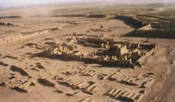 |
Gaochang Ancient City
The Gaochang Ancient City lies in between the Sanpu and Erpu villages 40 kilometers to the east of Turpan City, which means "the King City". Ascending a height to enjoy a distant view, one can see the whole city in a plane shape of an irregular square, which is divided, into three parts the exterior city, interior city and the palace city. The total area is about two million square meters.
Built in the first century B.C. and originally called Gaochangbi, it used to be a garrison town and later became a key point along the ancient Silk Road. By the seventh century it held sway authority over 21 other towns and the practice of Buddhism led to the establishment of many monasteries and temples. In the ninth century, the Uigur established the Kharakhoja Kingdom here and Manicheamism flourished. The city was burnt down around the 14th century, during a period of warfare that lasted 40 years. |
 |
|
Astana-Karakhoja Ancient Tombs
Astana-Karakhoja Ancient tombs Known as “the Underground Museum” and widely valued by Chinese and foreign archaeologists and historians, this group of ancient tombs is forty kilometers southeast of turpan city proper and six kilometers from the ancient city of gaochang. Astana means “capital” in Uygur and Karakhoja is the name of a legendary hero of the ancient Uygur Kingdom who removed the evils from the people by killing a vicious dragon.
The tomb complex is 5 km (3.1miles) from east to west, and 2 km (1.2miles) from north to south. Gravel boundaries separate the tombs by family. The paternal family burial order was strictly followed, similar to the system in the Hexi Corridor (today's Gansu Province), and even in central China. Generally, husband and wife were buried together. In some cases, one man was accompanied by two or three women. |
 |
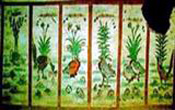 |
|
 |
Emin Minaret(Sugong Pagoda)
Emin Minaret is the largest extant old tower in Xinjiang; it is the only Islamic tower among the hundred famous towers in China.
Standing 2 km (1.24 miles) east of Turpan, Emin Minaret was built in 1777 in honor of the heroic Turpan general, Emin Khoja. He was an outstanding patriot who defended the unification of China throughout his life. It is made of sun dried bricks and is decorated with delicate geometric and floral patterns. The adjoining mosque has a latticed ceiling and a domed sacred space, all supported by wooden pillars. From the top of the mosque there is a good view of the surrounding vineyards and mountains. |
|
The Karez Well
It is an irrigation system of wells connected by underground channels. Karez systems are the crystallization of ancient people's diligence and intelligence. At its peak, the karez irrigation system exceeded 5,000 km (3,106 miles) and was also referred to as "the underground Great Wall". It is among the three ancient major irrigation projects with the other two being Ling Canal and Dujiangyan Irrigation Project.
|
 |
|
 |
The Flaming Mountain
The Flaming Mountain is located in north Turphan Basin of Xinjiang Province. It is a small mountain running across the basin. The mountain is combination of red sand and rocks that makes the mountain looks like a red dragon sleeping on the area basin.
In the best-known Chinese novel "Journey to the West", the Flaming Mountain in the novel is the mountain fill with different evil characters who fight with the high monk Tang and his three disciples. There are many old legendary stories make this mountain unique, attractive and with lots of room for wild imagination.
The mountain is barren and extremely hot in summer. During the trek approaching the mountain, visitors will find the soles of their shoes soften in the intense heat. |
|
Grape Valley
Turpan, a place truly flowing with milk and honey in the Turki language, is famous for its fruits. Among them, grape is the most famous.
Every August the sweet air will herald the vintage. The best place to enjoy the grapes is Grape Valley.
Located in the Flaming Mountain 13 km (8 miles) of Turpan, the Grape Valley runs 8km (5miles) from north to south at a width of 0.5km (03.miles). This green paradise of 400 hektares (988 acres) is covered with layer upon layer of grapes.
Grape Gorge, with its shady vineyards and fruit-laden trees, provides you with a welcome place of relaxation amidst hundreds of square miles of sand. |
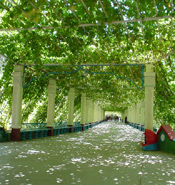 |
|
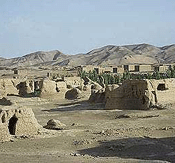 |
Ancient City of Jiaohe (Yarkhoto)
The Ancient City of Jiaohe is 10km (6 miles) west of Turpan in the Yarnaz Valley. Jiaohe means "intersecting rivers" and the ruins are located on top of a 30 meter (98ft) cliff carved out by 2 long dried up rivers. 2000 years ago, Jiaohe was powerful and important - it was the capital of the state of South Cheshi, one of the kingdoms of the Han dynasty (206-220BC) and was eventually incorporated into the Uighur empire in the 9th century BC. The city was at its cultural peak under the Uighurs, but Mongol rebellions led to its demise and by the Yuan dynasty (1280-1368AD) Jiaohe was deserted.
As the largest, oldest and best-preserved earthen city in the world, Jiaohe is 1,650 meters (5,413 feet) at its longest and 300 meters (984 feet) at its widest; with an area of 220,000 square meters (2,368,168 square feet). |
|
Bizaklik Thousand Buddha Caves
As Buddhism was the first religion from abroad introduced to this area, Xinjiang witnessed the earliest development of Buddhist cave art in China. Soon after the religion's establishment in the region, Turpan became the Buddhist center on the Silk Road owing to its geographic location. Among the Buddhist caves found in Turpan, Bizalkik Thousand Buddha Caves are considered most valuable.
Bizalkik Thousand Buddha Caves stand high on the cliffs of west Mutou Valley under the Flaming Mountain, 45 km (28miles) east of Turpan. Of the 83 original caves, 57 caves currently remain. The murals cover an area over 1, 200 square meters (12,917 square feet) in more than 40 caves.
|
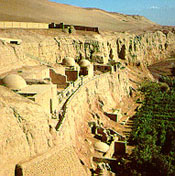 |
| |
Recommended China Tours Including Turfan:


|
|
| Other City |
|
|
 |
| Private China Tours |
|
|
 |
|

